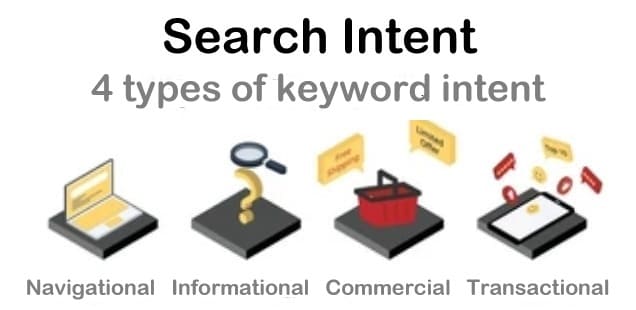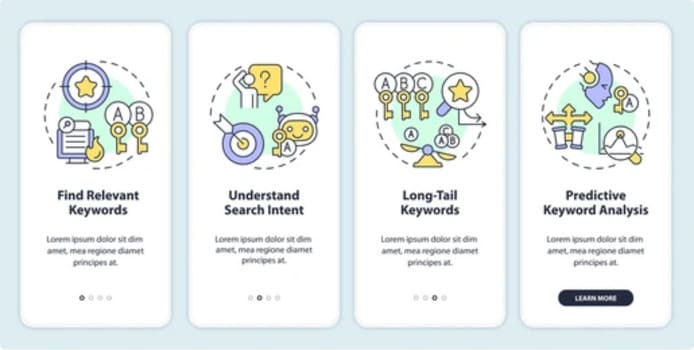What is Search Intent And Why You Need It For SEO
Info About Search Intent
Understanding search intent is one of the things that makes a real difference in how well a website or piece of content performs on Google.
If you want to get your content in front of the right people at the right time, knowing why someone is searching for something is actually really important.
In this article, I’ll break down what search intent means, the different types, why it matters for SEO, and how to figure it all out. Then you can put all this info to work in your digital marketing game plan.

What is Search Intent?
Search intent, sometimes called “user intent,” is basically the reason behind a search query. When someone types something into Google, they have a goal in mind—even if they don’t spell it out for you.
Sometimes, they just want information. Sometimes, they want to make a purchase. Other times, they’re looking for a specific website or page.
Figuring out what that goal is helps you match your content with what people are actually looking for.
Google and other search engines are really focused on giving users exactly what they want. This means that understanding and matching that intent isn’t something you can ignore if you want decent search rankings or traffic.
It’s about creating content that actually answers the user’s question or solves their problem, not just stuffing keywords everywhere.
When you check out top-performing websites, you’ll notice they address visitor needs directly—that’s the power of understanding intent.
Let’s say someone types in a question about fixing a dripping faucet. Their intent is to solve a problem. If your page doesn’t give them the steps or clear advice, they’ll move on quickly.
Google wants to keep users happy, so matching your content with intent matters for both rankings and user loyalty.
4 Types of Search Intent
All the different reasons someone might search online usually fall into one of four buckets. Here’s a quick rundown on what these are and some clear examples to show what they look like in action:
Not every query fits perfectly into just one of these categories, but most will lean heavily toward one type.
Google’s algorithm got pretty smart at recognizing these differences and tweaking the results you see based on intent instead of just keywords.
Sometimes, a user will have mixed intent—such as searching for “best laptops” then deciding to actually buy—but Google’s algorithm adapts the results accordingly.
By recognizing these types, you can craft the sort of content that searchers expect. If you offer an informational blog post for an informational query, your chances of showing up in search go up.
But if you confuse intent—like listing product sales pages when the visitor just wants to get information—your content will likely struggle to perform.
Why Search Intent is Important for Rankings
Matching your content with what users are trying to do makes search engines way more likely to serve up your site in the results.
Google uses search intent as a major part of its ranking algorithm. If your page matches the reason behind a searcher’s query, you have a much better shot at appearing on the first page.
Think about it like this: If someone searches for “best travel cameras 2024” and they come to a page selling one specific camera instead of reviewing or comparing several models, they’ll probably leave fast.
Google picks up on things like this, and your rankings can slip if your content doesn’t match intent.
Staying on top of search intent can help you grab higher rankings, drop bounce rates, and keep people on your site longer. It also means you’re setting your business up to actually provide value, not just collect clicks.
Remember, Google’s focus is on the end user—creating content that helps the searcher is your best bet for long-term SEO success.
Search intent evolves over time. As user habits, device usage, and search behaviors change, so do the ways people phrase their queries and what they expect in return.
By tuning in to these shifts, you can stay ahead of your competition and make your site stand out.

How to Decide Search Intent
Figuring out the search intent behind a keyword or phrase doesn’t need to be super technical. Here’s how to go about it:
Mixing all this together gives a really clear idea of what Google thinks people want. If your page can deliver that (and do it better or more clearly than others), you’re in a good spot for better rankings.
You may also want to look at comments, forums, or related searches to get a deeper sense of what users are hoping to find with each keyword.
Sometimes, user behavior helps signal intent, too. If a certain keyword brings lots of people who quickly leave your site, it could mean the intent doesn’t match your content.
In those cases, update your page with more useful infomation to line up with what searchers expect.
Applying Search Intent in Your Marketing Strategy
Using search intent in your marketing approach isn’t just about blogging or SEO. It works everywhere you’re creating content or trying to reach people online. Here’s how to make it work in your strategies:
- Content Planning: Build content for each stage of the user’s adventure. Create informational guides to answer broad questions, list posts and reviews for those in research mode, and landing pages for transactional keywords
- PPC and Paid Search: You get a better ROI (return on investment) if you target transactional keywords with your ads, not just random informational terms. This gets your products in front of people already looking to buy
- On-Page Optimization: Make sure the language, calls to action, and structure of each page actually fit what the user wants to do. Keep things relevant; don’t pitch products in a tutorial unless it feels natural and actually helps.
- Content Formatting: For informational searches, clear headings, bullet points, and visuals usually help. For commercial or transactional searches, highlight deals, reviews, ratings, or trust badges. It’s all about matching how people want to take in info.
Sticking to these steps helps make sure users land on the right content and have a better experience on your site. It also keeps that important trust going between your brand and your visitors.
One more tip: map your content calendar based on user intent.
For example, create clusters of articles that link together and cover both broad and narrow questions, helping users move smoothly through the funnel toward action.
Ranking High in Search Engines Through Search Intent
If you want to move up search rankings, here are some steps to use that focus on search intent; these work across almost any niche or website type:
- Do Smart Keyword Research: Brainstorm and validate keywords, but always take the time to figure out what people actually want with those keywords. Use tools like Ahrefs, SEMrush, or even Google’s own autocomplete suggestions
- Align Content to Intent: Check those top-ranking results and use them as a clue. Don’t try to force your sales page to rank for a keyword where every other result is an indepth informational guide, or vice versa
- Update Old Content: Go through pages that aren’t performing as well as you’d like and see if the intent needs a refresh. Sometimes, a quick rewrite to match the format Google prefers (like a comparison or how-to) can make a big difference.
- Use Clear CTAs (Calls To Action): CTAs should reflect the user’s intent; provide product links for commercial pages, signup forms for transactional queries, and related reading for informational posts.
- Track and Adapt: Use Google Analytics and Search Console to keep an eye on what’s working. Look for bounce rate, time on page, and conversion data to figure out where users might be losing interest or not getting what they came for. Adjust your pages as needed.
By making intent-driven updates and focusing on what users really want, you can see improved rankings and, more importantly, more targeted traffic that’s likely to stick around and convert.
There are no shortcuts, but paying attention to what searchers are actually asking for is one of the strongest moves you can make in SEO.
Remember, the goal isn’t just higher rankings; it’s building an audience that trusts your site to meet their needs every time.
As you tune your pages, also look out for new SERP features like featured snippets, People Also Ask boxes, and video carousels. These offer extra visibility if you can answer questions directly or provide unique value.
Frequently Asked Questions
I get asked a lot of the same questions when it comes to search intent, so I’ve pulled together some quick answers that should clear things up:
Question: How do I tell what the search intent is for a keyword?
Answer: The best shortcut is to look at what Google’s already showing on page one. Are you seeing blogs, product pages, or info boxes? That tells you what Google thinks searchers want.
Question: Can search intent change over time?
Answer: Absolutely. New products, trends, and even changes in how people use language can mix up intent. Staying on top of updates and regularly checking SERPs helps you keep up.
Question: Is matching search intent all I need to rank well?
Answer: Matching intent is a super important piece, but things like site speed, backlinks, and user experience all play a role as well. It’s a big puzzle, and intent is one of the most important pieces.
Going Forward with Search Intent
Getting comfortable with search intent changes how you see SEO and content creation.
When you build pages that actually deliver what people need, you not only improve your rankings but also get more loyal visitors.
The best approach is to put yourself in your users’ shoes for every keyword, every page, and every campaign.
Experiment a little, pay attention to all the clues, and make changes based on what you find.
Pretty soon, you’ll notice your content showing up more often for the right people; it’ll start making an impact that’s a lot bigger than just higher rankings.
When you focus on helping visitors meet their goals, search engines reward you—and so do your customers.

